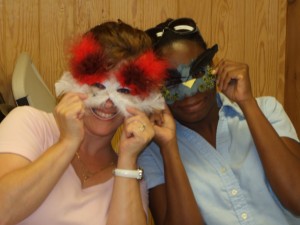As the Curator/Director of a historic house in a small town, I hear the refrains of “why don’t the schools come visit us?,” “where are the school groups?” all the time from other historic houses and traditional glass box history museums. When I inquire as to what they are offering the schools, the response, “we have all this STUFF.” Long gone are the days of build it and they will come when referring to school groups. In fact and in practice, that ended in 2002 with the signing of the No Child Left Behind Act or NCLB. Also known as teaching to the test.
Yes, there are ways to bring school groups and teachers back to your site. Warning: it takes a bit of work and planning on your part!
We KNOW that not all states will invite in museum professionals to help write education standards, so we must  work within the confines of those seemingly continuously changing requirements. I work in Georgia and they do a fruit basket turnover of the standards about every 6 years. This is a challenge when you have worked hard to develop programs aligned to the state standards and suddenly you are faced with a different set of standards that no longer fit your programs. (BTW, this is entirely outside of the Common Core standards which are a different discussion.)
work within the confines of those seemingly continuously changing requirements. I work in Georgia and they do a fruit basket turnover of the standards about every 6 years. This is a challenge when you have worked hard to develop programs aligned to the state standards and suddenly you are faced with a different set of standards that no longer fit your programs. (BTW, this is entirely outside of the Common Core standards which are a different discussion.)
The remedy to this is to work with whomever develops school programs at your site (often that has been me) to spend a half a day making notes on the standards. You will find the State Educational Standards on your State Department of Education website. For example, in 4th grade students need to know 1) causes of the Civil War, 2) 3 major battles, 3) who were Lee and Grant. Next comes some serious belly button studying and analysis — how can our site fit in here — what could we DO to help kids remember these facts. Hmmm, let’s see. If you have a site where slaves or, later, black servants worked, how about tackling the issue of slavery and the role of African-Americans in antebellum or post-bellum America during a tour? Bingo, one standard down.
But what about science? We can’t dissect frogs in the mansion! Noooo, but perhaps you have some technology  that was new at the time the house was built. Our house had a Delco light system. We can talk about electricity and how that changed American farming and lifeways. How about telegrams? The telegraph was vitally important to communication at one time. Corsets — always a hit. How did those impact human physiology, and interiors (think fainting sofas)? Bingo, two standards down!
that was new at the time the house was built. Our house had a Delco light system. We can talk about electricity and how that changed American farming and lifeways. How about telegrams? The telegraph was vitally important to communication at one time. Corsets — always a hit. How did those impact human physiology, and interiors (think fainting sofas)? Bingo, two standards down!
Be creative. Walk through your site, your collections, and your archives. You may not be able to serve every grade level this way, and that is OK. Be fantastic with 3rd grade standards, excel at meeting 8th grade standards. No one will fault you for not teaching American Revolution topics at a Civil War site (though in reality you probably can once you start digging).
The next way to reach back into the schools is directly through the teachers. This is a two-fold approach. 
First, once you have aligned your programs with the state standards advertise it to the teachers. They are not going to come to you looking, you have to go to them. This is also easier than it sounds. Don’t bother contacting the Principal, or even the AP — they don’t forward emails or letters. Spend a day data mining school websites to get the emails of teachers in the grades/subjects you are targeting. Craft a well-written email — be brief — outlining what you can do for the teacher and his/her students. Don’t waste time and money MAILING things. Teachers get sooooo much junk mail they toss most of it. Email Email Email. Only put about 6 to 10 addresses in the TO: box at a time so the school systems don’t make you as a spammer. Follow an initial email up with an email a month, even if it is only “Here’s what we’re up to this month..,” reiterate what you can do for them. 
The second way to reach teachers is through Professional Development classes. This sounds really scary if you’ve never presented or even attended one. We will tackle this topic next week! Stay tuned.
Michelle Zupan is the Curator & Director of Hickory Hill in Thomson, GA. She is the Chair of the AASLH Historic House Museums Committee



